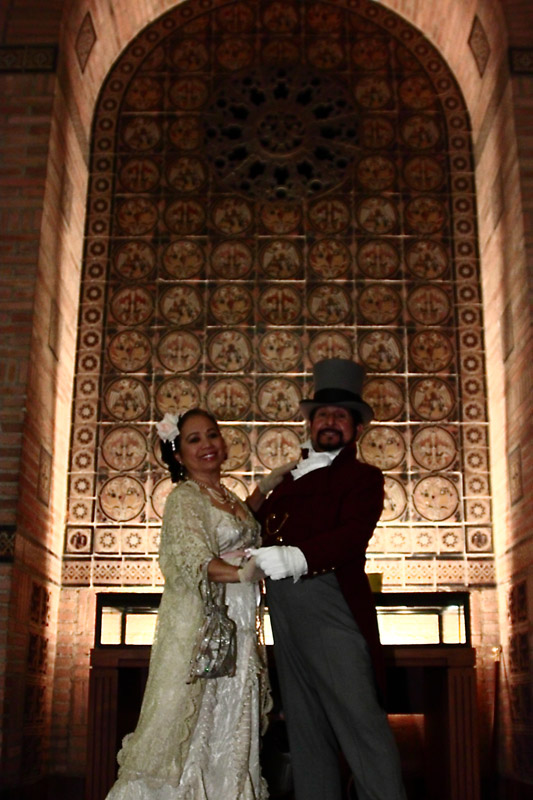Tammy Prara bends her knees in a slight curtsey. Then she and her husband weave in and out of other couples on the dance floor, forward and backward, holding hands and letting go. As they swivel into the place where they started the dance, the song ends.
Prara smiles and sighs, her shoulders relaxing.
Prara and her husband are back where they began minutes earlier ““ and years earlier. They met at a square dance when she was 25 years old, and have since been married for 17 years.
Now it is Saturday night, and they are at the 13th annual Jane Austen Ball, hosted by the Historical Ballroom Dance Club and the College Library.
“You feel so beautiful, so romantic, so feminine. It’s so sweet,” Prara said.
About 100 dancers gathered in the rotunda of Powell Library to learn dances from the English Regency. This period spans from about 1790 to 1820, which is when Jane Austen lived and wrote novels, including “Pride and Prejudice.”
“There are always balls in her books. And if you look in the books, the people that (the characters) dance with in the first balls are the ones they end up with. Elizabeth dances with Darcy and thinks he’s stuck up, but that’s who she marries,” said Emma Lewis Thomas, professor emerita of dance history.
At the time, dancing was one of the primary ways for young people to meet each other, said Cynthia Harper, co-founder of the club.
“Dancing was a big part of the social structure. You had to be a good dancer,” she said.
The ball in Powell began with a contra dance, in which couples stand facing each other in two lines ““ one for men, one for women.
“We’re going to play-act being aristocrats,” instructor John Hertz said to the dancers. “I have to warn you, it might be difficult. American culture is so very ingrained in us.
The English nobility stood straight but not stiff, Hertz said, and dancers should try to achieve this easily elegant posture. Today, most people slouch, he added.
Costumes were optional at the ball, but Prara dressed in period clothing: a mauve, floor-length gown with an empire waist. Her blonde hair was swept up, but a few curls dangled around her temples.
“(Dressing up) puts you in the atmosphere. It’s like Halloween, you get to dress up and put on make up,” said Prara, who is from Apple Valley, a town about 100 miles from UCLA.
Along with her husband, Prara attended the ball with her two daughters and their home schooling group. Comprised of three mothers and five teenage daughters, the group has spent the last several months reading and analyzing English literature.
Many of Austen’s commentaries about relationships still ring true today, Prara said, and the girls loved the sarcastic character Elizabeth in “Pride and Prejudice.” The ball can help the girls better understand Austen’s world, she said.
“You just can’t understand watching the (Jane Austen) movies. It’s not the same as being in the middle of a set and dancing and watching people dancing,” she said.
One of the purposes of the club is to teach people about history by immersing them in it, Harper said. The club was co-founded in the 1990s by James Zimmer, then a musicology student in the world arts and cultures program, and Harper, who was a UCLA staff member. At the time, Zimmer would offer dance lessons four nights a week in Ackerman Student Union and in Kerckhoff Hall.
A class on Renaissance and Baroque dancing helped spark Zimmer’s interest in historical dance. He was also inspired by the Friends of the English Regency, a group that meets in Culver City on a monthly basis to learn the dances of the period.
Zimmer and Harper host 11 total vintage dances throughout the year, including a Romeo and Juliet Renaissance Ball and an American and French Revolution Ball. The Jane Austen Ball is always one of the most popular because her books are still widely read, Zimmer said.
Alina Kurland, a first-year psychology student who decided to attend the ball with a friend after seeing a flier on her way to brunch that morning, noted the huge differences between Regency dances and modern dances.
“There’s a lot less touching, that’s for sure. The music is also different,” Kurland said. “It was fun to try out.”
Steven Homestead, who graduated from UCLA in 2005 and has attended a few Jane Austen Balls, said Regency dancing is tightly structured. For example, in one of the waltzes couples were paired with another couple, and each unit performed the same dance moves at the same time.
“You’re sort of dancing for the whole crowd,” he said. “When you go to clubs today, you’re dancing for yourself, in a circle, or with a girl. At the Jane Austen Ball, you’re dancing with your partner, and you and your partner are dancing with other couples. And as a group, you mirror what the whole room is doing.”
Tony Munoz, who has been a ballroom teacher and dancer for 45 years, said he would not mind living in the highly proper Regency period.
“I am a gentleman,” he said. “I open doors, stand up when ladies come in the room. It’s my way of living.”
At the ball, Munoz sported a maroon wool coat and a top hat. He bought his gray pants for three dollars at a thrift shop and reworked them to make them compatible with Regency style.
“I’d be happy to dress like this all the time, and not in tuxes and sports jackets,” Munoz said. “I would feel comfortable in the Regency period if we turned back time.”
